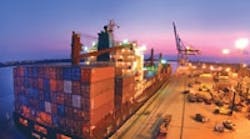When disaster strikes the Port of New Orleans, which along with four other ports on the lower Mississippi River make up the largest port area in the United States -- and fifth in the world, it impacts a lot of people.
The port serves 2,000 vessels and has 22 million square feet of cargo-handling area. It handles 11.4 million tons of general cargo annually -- at least it did before Hurricanes Katrina and Rita slammed into the area.
According to Chris Bonura, Port of New Orleans spokesman, the amount of cargo moving in and out of the area as of mid-December is not known, but he does state that ship arrivals were at 50% of normal activity -- a percentage that increases weekly.
"We don't think it's the same volume per ship that we normally get. It's lagging a little bit behind," Bonura says. "But we are pretty happy with 50% at this point, and we continue to push on that.
"The goal that our president and CEO set was to be somewhere between 80% and 100% for ship calls [arrivals] six months after the storm, which would be by the end of March. During a normal week we might have 30 to 40 ship arrivals."
The ports also have access to six major railroads -- more than any other U.S. seaport.
With a cost-efficient mode of transportation crippled, it's no wonder manufacturers in the steel, coffee and wood industries are concerned about its well being.
In a Nov. 1, 2005, press release, Procter & Gamble Co. noted that coffee sales were down 5% due to the disruption of the coffee business caused by Hurricane Katrina. The Cincinnati-based company's Folger's coffee plants are located in New Orleans.
Knowing what is at stake, the Port of New Orleans quickly started moving cargo.
"Our first shipment after Katrina was steel that was in one of our terminals," Bonura says. "It arrived before Katrina, and they barged to the Hyundai plant in Alabama less than two weeks after Katrina."
Bonura also notes that the area where 70% of the Port of New Orleans facilities are, called the Uptown River Terminals, had no flooding and minor to moderate wind damage. Many of those terminals are configured for breakbulk (on pallets or bundled) cargo -- steel, metals, coffee and forest products. All the terminals in that area were operating shortly after the hurricanes.
As for labor in the area, Bonura says the port is watching the lissues very closely.
"We have enough [workers] right now to deal with the cargo we have, but we know as we ramp up we are going to need more."
The trucking industry also took a hit from the storms.
"We've been putting out the call nationally to recruit truckers to come into New Orleans. We have 250 to 275 back in town right now, and they are making a lot more turns to deal with the volume that we have."
Pre-Katrina there were about 1,000 truckers doing 1,500 turns. Post-Katrina the 250 to 275 truckers are doing 600 turns on a busy day, according to Bonura. As for the state of the port, Bonura's first message is that the port is open.
Secondly, "If manufacturers had cargo that they assumed was damaged by Katrina, it might not be as bad as they think. If they were Uptown, chances are their cargo can be salvaged or it plain out survived. Katrina did deal us a blow, but the river is still here, and it's still a mass transportation network."



